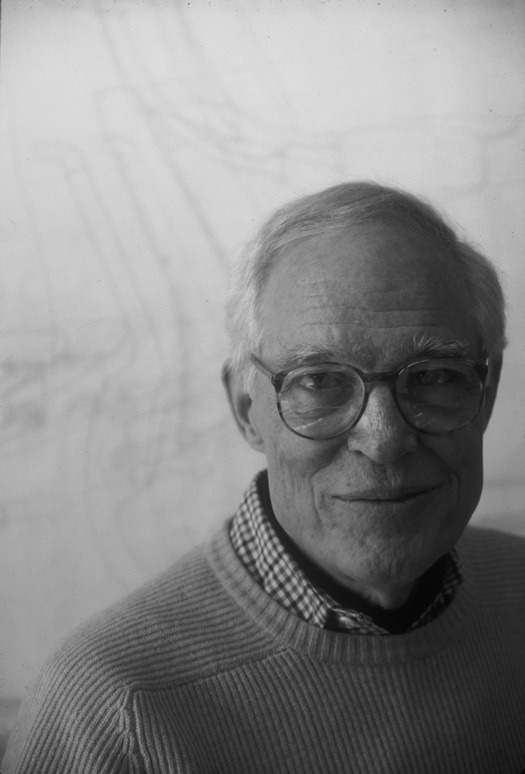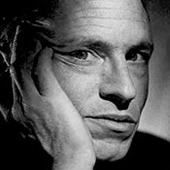
July 3, 2013
Niels Diffrient: The Human Factor

Niels Diffrient, photograph by Dorothy Kresz, 1999
Niels Diffrient spent the last decades of his life working, largely on his own, in a restored barn in Ridgefield, Connecticut. In 1999, photographer Dorothy Kresz visited him there to take pictures for a brochure that would introduce the Freedom Chair, a revolutionary piece of office furniture that Diffrient designed when he was just past 70. The photographs in this slideshow form a double portrait of a man and the environment he had created in which do the work that he loved. Below, journalist Phil Patton remembers what made Diffrient so unique.
Niels Diffrient died June 8, age 84. This pioneer of human factors and ergonomics brought optimal dimensions not just to products he designed, but to many others that relied on his templates of the body.
I had communicated with him just a few weeks before, trying to set up an appearance for him this fall. We discussed the design of infotainment systems in automobiles, a problematic area of design, to say the least. Interface, interaction, user experience, ergonomics, human factors: we can’t even neatly name it but it was all in his terrain.
Diffrient will be seen as a pioneer of design’s shift from thinking about shaping objects to shaping the experience of the person who uses them. He may have worked with numbers and templates, but his overriding desire was to make the world better for living human beings.
He wore an air of cosmopolitan wisdom. It was a surprise, then, to hear he had been born in rural Star, Mississippi. The family migrated north to seek jobs in the factories of Detroit. His father worked on the line at General Motors; Niels ended up at Cranbrook and entered the circle of Eero Saarinen, Charles Eames and Harry Bertoia. Then, thanks to a Fulbright scholarship, he arrived in Italy in time for the high period of Italian modern design. He worked with Marco Zanuso.
Back in the States, he found a job with Henry Dreyfuss, where he continued the firm’s pioneering efforts in ergonomics in the Humanscale standards. Later, for the company also called Humanscale, he put these principles into practice in office chairs. Most notable among these was the Freedom Chair, introduced in 1999.
His autobiography, Confessions of a Generalist, published last year, reveals a life with adventures far beyond lab research. While designing aircraft interiors for TWA he met Howard Hughes, the mad billionaire.
He watched technology change. He had defined the proper angle of the keyboard and the relationship of chair-to-desk. But now computers were laptops and used on laps, wherever bodies bent or lounged. Keyboards were flat — even the finger-friendly scoops of keyboard keys have been abandoned in the desire for abstract beauty.
I remember attending a party a few years ago with Diffrient. The music was loud and the crowd jammed tight. Twentysomethings held drinks in one hand and texted with the other — communicating in a mode that was eons from the proper ergonomic angle of chair or back. But Diffrient simply shook his head in bemusement. His interest was not in devices but in people and their constantly unfolding nature. That is the real human factor.
Observed
View all
Observed
By Phil Patton
Related Posts

Graphic Design
Sarah Gephart|Essays
A new alphabet for a shared lived experience

Arts + Culture
Nila Rezaei|Essays
“Dear mother, I made us a seat”: a Mother’s Day tribute to the women of Iran

The Observatory
Ellen McGirt|Books
Parable of the Redesigner

Arts + Culture
Jessica Helfand|Essays
Véronique Vienne : A Remembrance
Recent Posts
Why scaling back on equity is more than risky — it’s economically irresponsible Beauty queenpin: ‘Deli Boys’ makeup head Nesrin Ismail on cosmetics as masks and mirrors Compassionate Design, Career Advice and Leaving 18F with Designer Ethan Marcotte Mine the $3.1T gap: Workplace gender equity is a growth imperative in an era of uncertaintyRelated Posts

Graphic Design
Sarah Gephart|Essays
A new alphabet for a shared lived experience

Arts + Culture
Nila Rezaei|Essays
“Dear mother, I made us a seat”: a Mother’s Day tribute to the women of Iran

The Observatory
Ellen McGirt|Books
Parable of the Redesigner

Arts + Culture
Jessica Helfand|Essays

 Phil Patton is an author and curator who writes on autos for
Phil Patton is an author and curator who writes on autos for